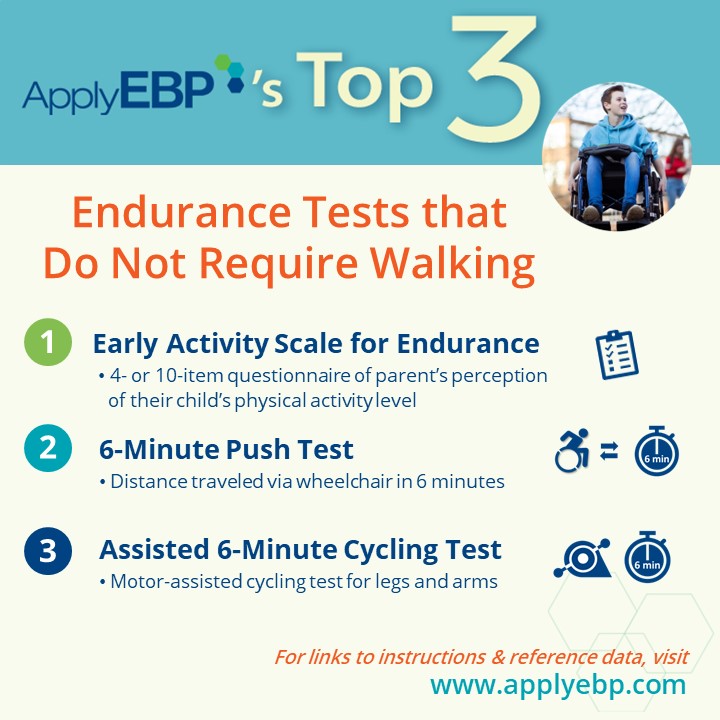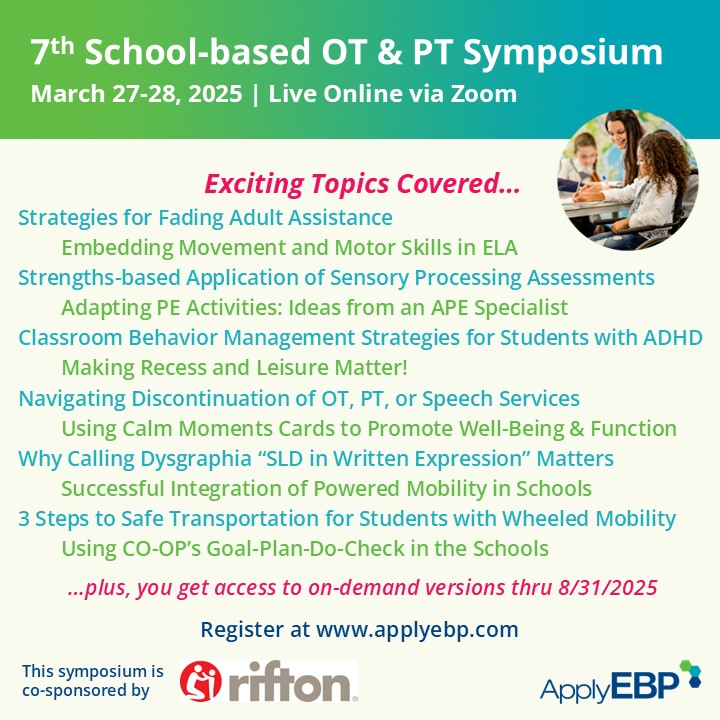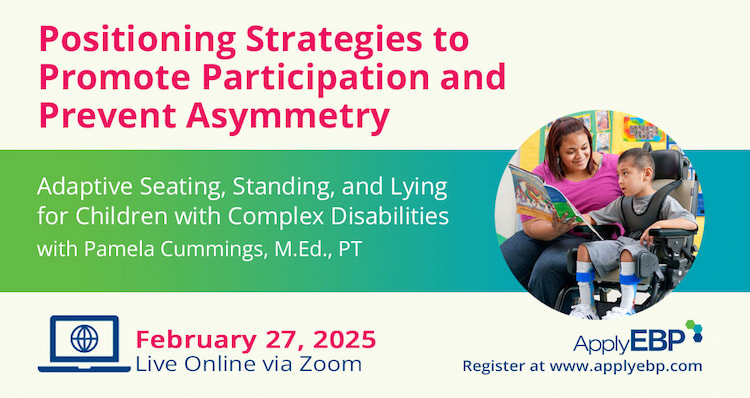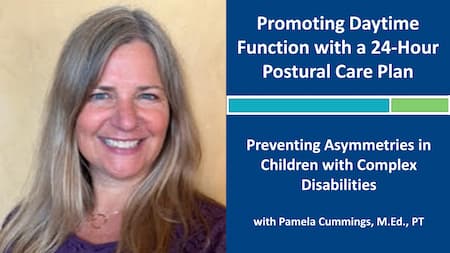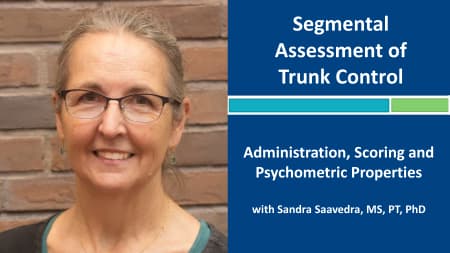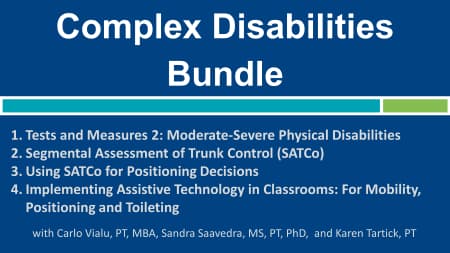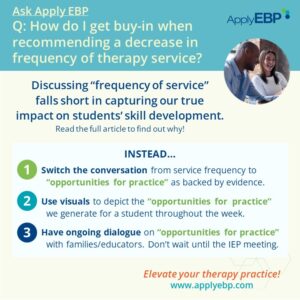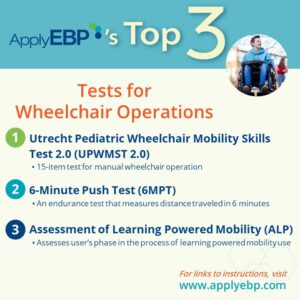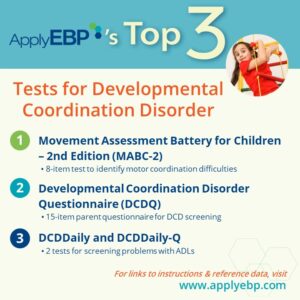Ask Apply EBP
Top 3 Endurance Tests that Do Not Require Walking
Note that this article is part of a series of articles on assessment. If you have not done so, first, read this articles:
-
-
-
- Must-Have Test and Organizing Your School-based Assessment – discusses the 5 critical reasons for assessing participation first
- 3 Principles for Selecting Tests – discusses the 3 principles to use when selecting tests at the activity and body function & structure levels
-
-
Q: What are the best tests for…Endurance that do not require walking?
Endurance was typically hard to measure for our clients who are not yet walking or for those who have difficulty walking. The great thing is that we now have tools that do not require walking. Here are our 3 favorites. (If you are interested in endurance tests with walking, click here.)
1. Early Activity Scale for Endurance (EASE)
The EASE uses a questionnaire to estimate a parent’s perception of their child’s physical activity level. There are 2 versions: a 4-item and a 10-item questionnaire.
-
-
- Test instruction: Article about the 10-item Questionnaire | Article about the 4-item questionnaire
- Where to get the questionnaire: 4-item Questionnaire | 10-item questionnaire
- Time for administration: a few minutes
- Equipment needed: none
- Why we like this test: The 10-item questionnaire is moderately correlated with the 6-Minute Walk Test (6MWT) (Fiss et al, 2019), while the 4-item questionnaire has been shown to be a valid predictor of physical activity (Wentz et al, 2020)
- What to note: As additional resource, Jeffries et al (2020) have also reported a longitudinal trajectory of the 4-item EASE scores for children with cerebral palsy, ages 1.5 to 11 years.
-
2. 6-Minute Push Test (6MPT)
Based on the 6-minute walk test, the 6MPT measures the total distance traveled via wheelchair in 6 minutes on a 10-meter course.
-
-
- Test instruction: Click here for the 6MPT procedures
- Time for administration: 10-15 minutes
- Equipment needed: timer, floor tape, cones, heart rate monitor
- Why we like this test: Measures the ability to wheel for longer distances.
- What to note: Wheelchair weight has a big influence on the distance; hence, we do not recommend using “norms” or averages from studies.
-
3. Assisted 6-Minute Cycling Test
The A6MCT is designed for late- or non-ambulant children diagnosed with a neuromuscular disorder. It requires the use of motor-assisted mobility trainer (ergometer). Clients are tested with leg cycling and arm cycling.
-
-
- Test instruction: Click here for the test procedures
- Equipment needed: timer, chair with back support, motor-assisted mobility trainer (ergometer)
- Why we like this test: The motor-assisted ergometer allows children with sever muscle weakness to complete the test.
- What to note: You have to purchase an ergometer with motor assist…great news, they are now easily available online.
-
If you would like to learn more about working with children with more complex disabilities, take…
References
Fiss, A. L., Jeffries, L., Yocum, A., McCoy, S. W., & On Track Study Team. (2019). Validity of the Early Activity Scale for Endurance and the 6-Minute Walk Test for children with cerebral palsy. Pediatric Physical Therapy, 31(2), 156-163.
Jansen, M., De Jong, M., Coes, H. M., Eggermont, F., Van Alfen, N., & De Groot, I. J. (2012). The assisted 6‐minute cycling test to assess endurance in children with a neuromuscular disorder. Muscle & nerve, 46(4), 520-530.
Jeffries, L. M., Fiss, A. L., McCoy, S. W., & Avery, L. (2020). Longitudinal change in common impairments in children with cerebral palsy from age 1.5 to 11 years. Pediatric Physical Therapy, 32(1), 45-50.
McCoy, S. W., Yocum, A., Bartlett, D. J., Mendoza, J., Jeffries, L., Chiarello, L., & Palisano, R. J. (2012). Development of the Early Activity Scale for Endurance for children with cerebral palsy. Pediatric Physical Therapy, 24(3), 232-240.
Verschuren, O., Ketelaar, M., De Groot, J., Vila Nova, F., & Takken, T. (2013). Reproducibility of two functional field exercise tests for children with cerebral palsy who self‐propel a manual wheelchair. Developmental Medicine & Child Neurology, 55(2), 185-190.
Wentz, E. E., Bjornson, K. F., Kerfeld, C. I., Cicirello, N., & Fiss, A. L. (2020). Walking performance, physical activity, and validity of the early activity scale for endurance in young children with cerebral palsy. Physical & Occupational Therapy In Pediatrics, 40(5), 557-570.
Find More Answers to Your Questions in Our...
Featured School
Symposium
Featured Live
Workshop
Featured On-Demand
Webinar
Promoting Daytime Function with a 24-Hour Postural Care Plan
Featured Webinar
Bundle
Complex Disabilities Bundle
Have a question?
Submit here…
*Clicking submit will send your question directly to our email inbox. Your name and email will let us know that your submission is real (not spam). We will not include these in our posts, unless you tell us to include your name. Please read our privacy policy here.
All infographics and videos on www.applyebp.com are intellectual properties of Apply EBP, LLC
You may use the infographics and videos for free for any non-commercial, educational purposes. Please cite the source as “Apply EBP, LLC” and a link to the source article. If you plan to use any infographic or video for commercial purposes (i.e., for profit), please email Carlo@applyebp.com to obtain a written permission. Permission can be granted on a case-by-case basis.

